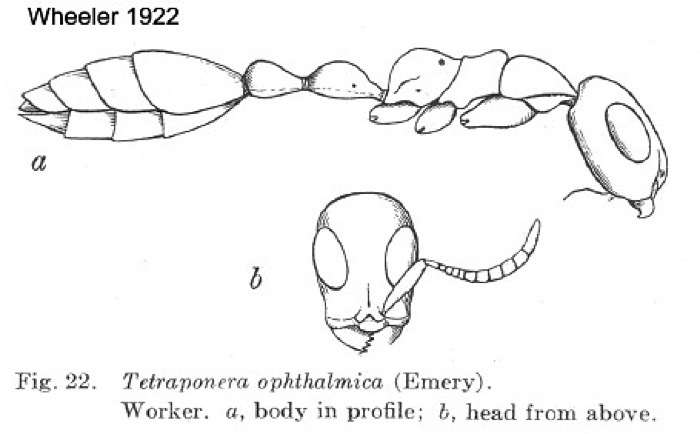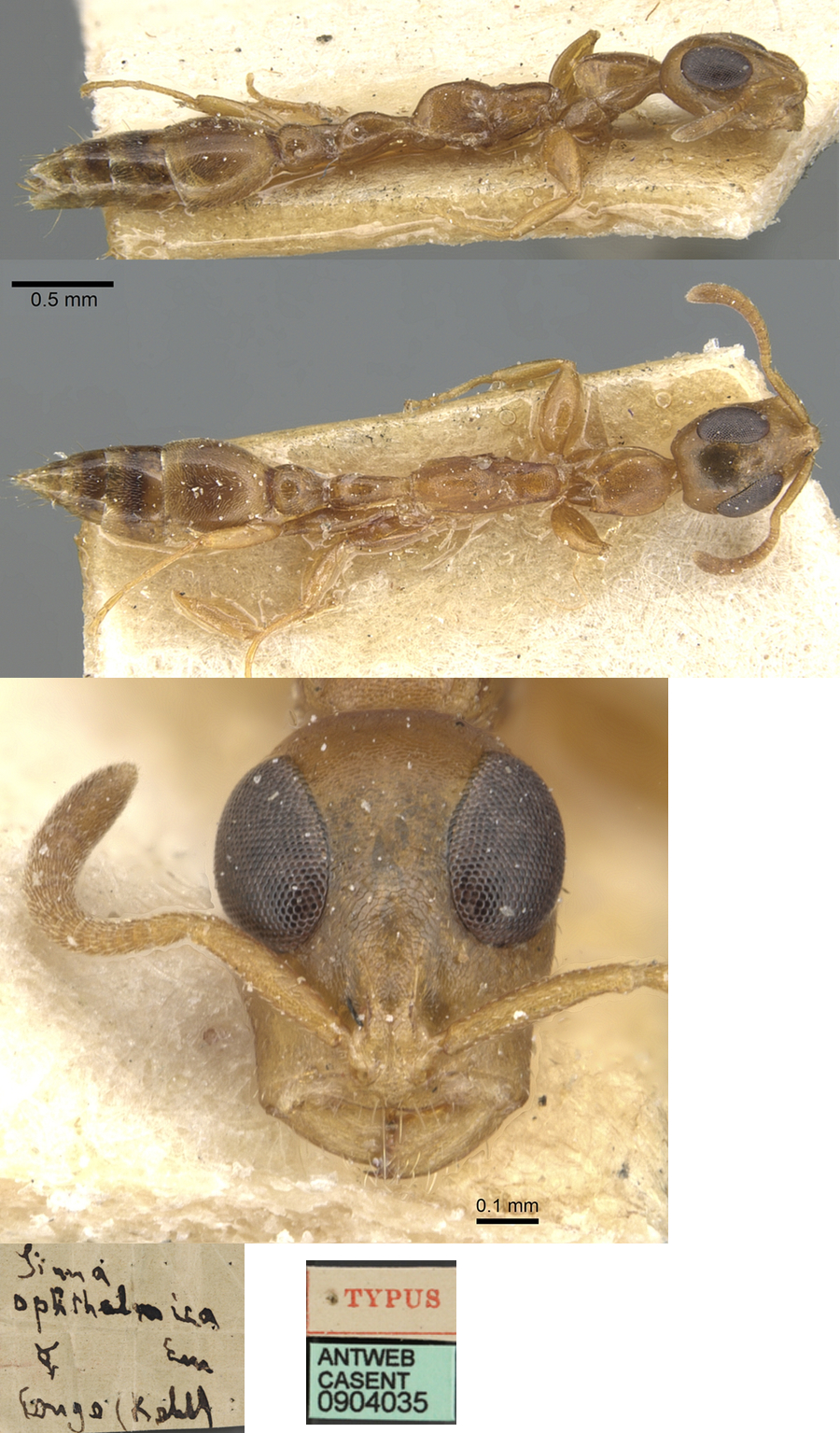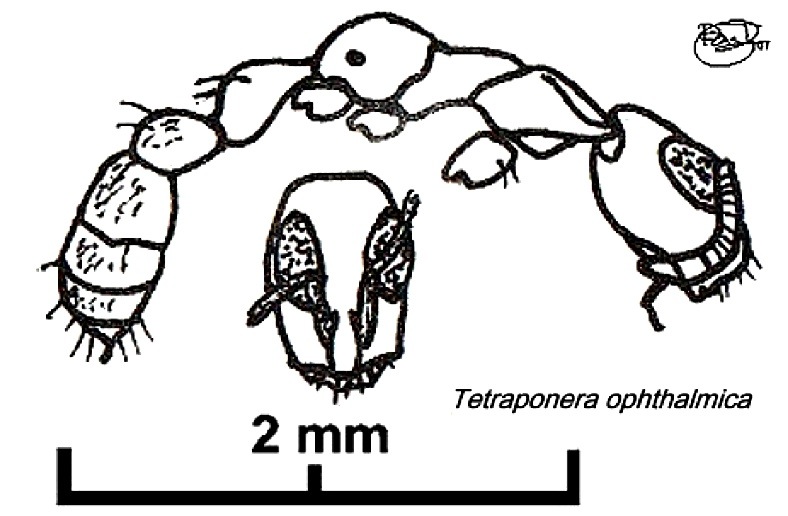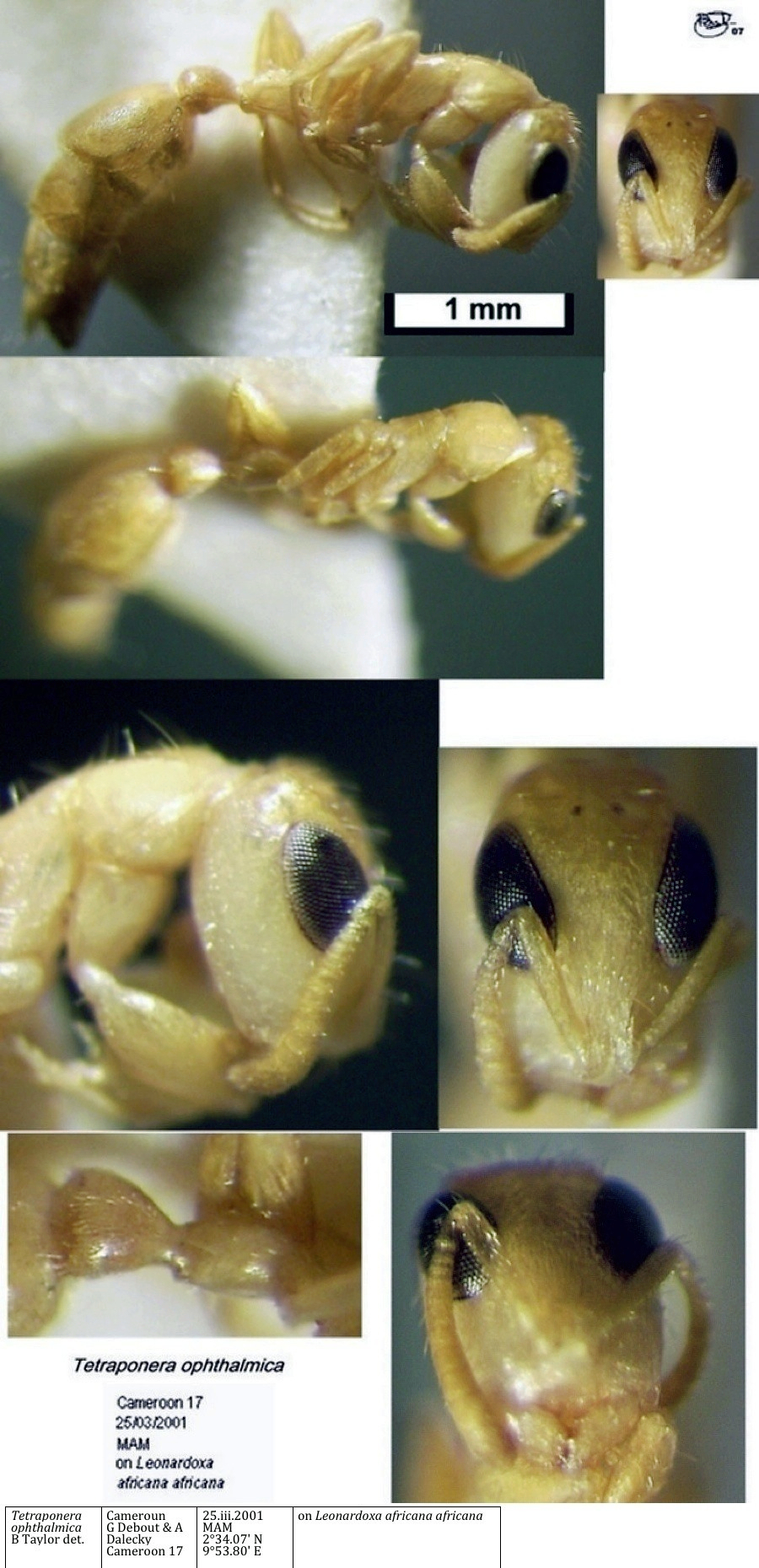Tetraponera ophthalmica (Emery)
 Type
location Cameroun (Sima ophthalmica n. sp., Emery,
1912b: 98,
worker; in Tetraponera, Wheeler, 1922: 107) collected at
Batanga by L Conradt Type
location Cameroun (Sima ophthalmica n. sp., Emery,
1912b: 98,
worker; in Tetraponera, Wheeler, 1922: 107) collected at
Batanga by L Conradt
worker and queen described (see Bolton,
1995)  . .
|
I have given the form described as Tetraponera
unidens by Santschi (1928d: 60, illustrated, queen) a new
status as a full species and the senior synonym of nasuta.
Similarly, (2014) I have separated Tetraponera tenebrosa Santschi
as a distinct species.
Ward (1990: 489) gave the "current nominal combination" T.
ophthalmica Emery (1912: 98; from Cameroun), Tetraponera
ophthalmica tenebrosa Santschi (1928: 61; from Zaïre) and Tetraponera
ophthalmica unidens Santschi (1928: 60; from Zaïre); with the
annnotation that he had examined specimens.
|
 Emery's (1912b)
description is at Emery's (1912b)
description is at  . Wheeler's (1922: 107)
illustrated note is
at . Wheeler's (1922: 107)
illustrated note is
at  . Santschi's (1928d) description of tenebrosa,
is at . Santschi's (1928d) description of tenebrosa,
is at  . .
Wheeler (1922, illustrated, full profile, full-face
head, matching my drawing, below) listed a second Cameroun finding (at
Batanga, G. Schwab), plus Zaïre; the specimen from Zaïre is pictured in
Hölldobler & Wilson (1990, page 56). J. Bequaert collected nine
workers at Thysville "running on limbs of Barteria fistulosa,
whose cavities were not inhabited by ants" [i.e. there were no Tetraponera
aethiops]. Forel (1916) noted Kohl had collected it at Bengemeza
and St Gabriel, tending aphids on Barteria fistulosa, noting
that the specimens TL about 4 mm were a little bigger than the type,
the propodeum more humped and smoothly passing from dorsum to
declivity, the petiole low, convex and narrow, twice as long as wide,
the postpetiole a little larger, cupiliform, and a little longer than
its posterior width.
|
 The photomontage of a
type worker is collated
from http://www.antweb.org/specimen.do?name=casent0913721. The photomontage of a
type worker is collated
from http://www.antweb.org/specimen.do?name=casent0913721.
|
 Nigeria specimens (Taylor, 1976: 39). WORKER.
TL
4.08 mm, HL 0.86, HW 0.53, SL 0.39, PW 0.36; CI 60 SI 80 EI 46 Nigeria specimens (Taylor, 1976: 39). WORKER.
TL
4.08 mm, HL 0.86, HW 0.53, SL 0.39, PW 0.36; CI 60 SI 80 EI 46
Colour yellow, shiny almost transparent cuticle. Fine, dense pubescence
restricted to gaster. Eye length 0.39 mm (0.45 of HL). No ocelli.
It was rarely collected on cocoa and cashew trees. Nests in dead wood
on trees.
Also reported from Ghana cocoa canopy by Room
(1971), including at 13 of his collections from cocoa canopy; and on
cocoa mistletoe (Room, 1972a, 1975), where it ranked 13th in terms of
presence/absence (on 24/175 plants). Also found on cocoa at Kade by
Majer (1975), using pkd (apparently in two samples, each with three
workers).
|
Oxford University Museum
specimens
Tetraponera ophthalmica
B Taylor det. |
Cameroun
G Debout & A Dalecky
Cameroon 17
|
25.iii.2001
MAM
2°34.07' N
9°53.80' E
|
on Leonardoxa africana africana
|
4
|
 |
|
 The
photomontage is of workers collected in Cameroun -
south-western tropical coastal forest area between Edéa and Campo
(McKey Wolbachia project, Cameroon 17). The
photomontage is of workers collected in Cameroun -
south-western tropical coastal forest area between Edéa and Campo
(McKey Wolbachia project, Cameroon 17).
Head near rectangular with slightly convex sides, both
anterior and posterior margins straight; in profile head near ovoid.
Eyes large, extending from about 1/3 point of face back to 1/6 from
occipital margin, ovoid but angled so closer together anteriorly; two
distinct ocelli. Scapes near transparent, reaching mid-point of face.
Overall appearance dull; face with quite dense very short hairs and
longer hairs on occiput. Pronotum dorsum near flat, very slightly
convex, with distinct right angled margins; fairly numerous long, fine
erect hairs. Petiole and postpetiole in profile domed dorsally in
profile, no ventral processes, petiole with a few quite long fine
hairs, postpetiole without hairs.
|
 The
photomontage is of a second worker (McKey Wolbachia project,
Cameroon 17). The
photomontage is of a second worker (McKey Wolbachia project,
Cameroon 17).
|
|